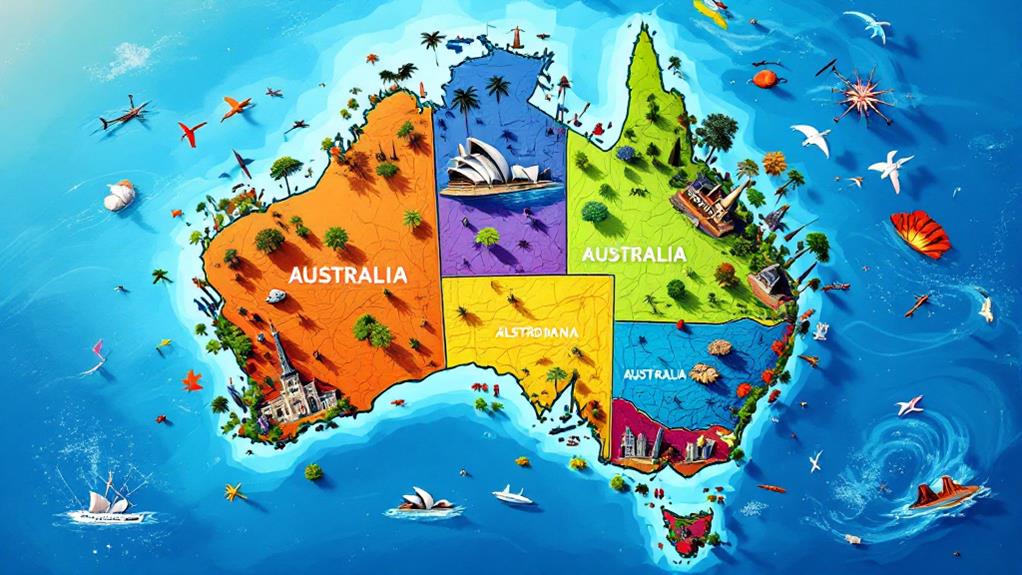Which Battle in WWII Prevented Japan From Attacking Australia?
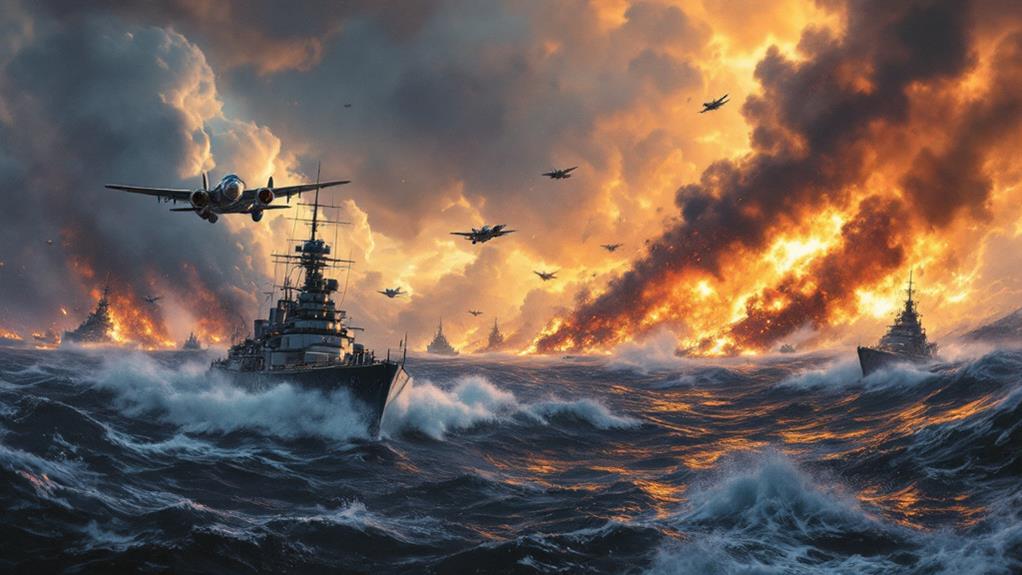
You're curious about which World War II battle stopped Japan from attacking Australia. It was the Battle of the Coral Sea in May 1942. This naval showdown marked a significant turning point in the Pacific War. American forces, with help from groundbreaking codebreaking efforts, thwarted Japan's plan to seize Port Moresby, which was essential for controlling the region and cutting off Australia's supply lines. Although both sides took heavy losses, the battle was a strategic victory for the Allies. The resilience shown during this clash guaranteed the safety of Australia and shifted momentum in the Pacific. There's a lot more to uncover about this epic battle.
Japanese Expansion Plans
In early 1942, Japan set its sights on expanding its reach in the Southwest Pacific, formulating a plan to attack Australia via New Guinea and the Solomon Islands. Their Japanese expansion plans included a strategic invasion of Port Moresby. By capturing this key location, the Imperial Japanese Navy aimed to establish dominance in the region and secure essential strategic advantages. This move would prevent Allied forces from disrupting Japanese supply lines to Australia, a significant step for their broader ambitions.
The plan wasn't just about land; air power played a central role. By seizing Tulagi initially, Japan intended to project air power effectively, safeguarding its bases and paving the way for the Port Moresby invasion. The Imperial Japanese Navy boldly estimated that three divisions—about 45,000 to 60,000 men—would suffice for this operation, contrasting with the Army's more cautious estimate of ten divisions.
However, the execution of these plans faltered due to the Battle of the Coral Sea in May 1942. This decisive naval engagement thwarted Japan's attempt to launch a direct attack on Australia, demonstrating the significant role of Allied forces in countering Japanese ambitions in the Southwest Pacific.
The Debate Over Invasion
The possibility of invading mainland Australia sparked significant debate among Japan's military leadership in early 1942. The Japanese Navy was enthusiastic to launch an invasion, believing it required only three divisions. In contrast, the Japanese Army saw it as an impractical venture, estimating a need for ten divisions to succeed. This disagreement in logistics and capability underscored the challenges of such a bold move. Meanwhile, battles like the Battle of Milne Bay and the Kokoda Campaign demonstrated the resilience of Allied forces, further deterring Japan from pursuing direct invasion tactics.
Air raids on Darwin and other Australian territories heightened military preparedness, causing alarm and leading to increased vigilance. Intelligence reports at the time revealed that Japan's initial aggressive stance had shifted. The focus moved from a direct invasion to a strategic shift aimed at isolating Australia, thereby preventing Allied air power from gaining strength in the Pacific. By late February 1942, the debate concluded with a consensus to isolate rather than invade. This decision marked a crucial moment in Japan's military objectives, redirecting their approach and influencing the broader Pacific conflict dynamics during World War II.
Australian Defense Concerns
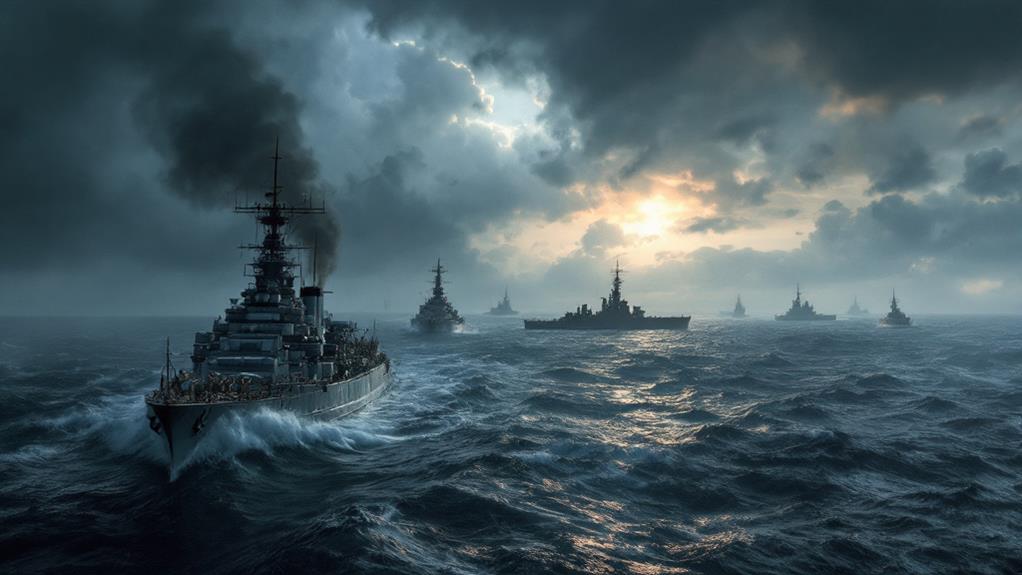
Amidst the growing threat of Japanese aggression, Australia faced intense pressure to bolster its defenses. The fall of Singapore in February 1942 was a wake-up call, leading Australian Prime Minister John Curtin to stress the urgent need for national defense. The fear of a Japanese invasion loomed large, heightening public anxiety. Though Japan initially considered invading Australia, operational disputes between its Army and Navy ultimately led to a strategy of isolation rather than direct confrontation.
The Battle of the Coral Sea in May 1942 was significant, as it marked a considerable halt to Japanese advances and reassured Australians about their security. Furthermore, the Kokoda Campaign from July to November 1942 played an essential role in turning the tide against potential threats to the continent. Air raids on Darwin in early 1942 further emphasized Australia's vulnerability, prompting increased military preparedness and a stronger alliance with American forces.
This perceived threat of invasion unified Australia, shaping both government policy and public sentiment. Australians rallied behind the need for a robust defense strategy, driven by the looming specter of war and the collaboration with allies to guarantee the nation's safety.
Prelude to Coral Sea
As 1942 unfolded, Japan set its sights on isolating Australia, a move that would cut off Allied support and control crucial supply lines. They planned an invasion of Port Moresby, a strategic target fundamental for dominating the region. The Japanese strategy involved capturing Tulagi and launching a two-pronged assault through New Guinea and the Solomon Islands, fortifying their position against Australia. This aggressive plan, if successful, would give Japan a significant advantage in the Pacific War.
You might wonder how the Allies knew about these plans. Well, American codebreakers intercepted Japanese communications, revealing the invasion strategy. Armed with this intelligence, the Allies began preparing a counter-offensive to defend Port Moresby. The upcoming Battle of the Coral Sea was central to this defense. It was a groundbreaking naval engagement, as it was the initial in history where aircraft, rather than ships, played the dominant role in combat.
Through the successful defense of Port Moresby in the Coral Sea, the Allies effectively thwarted Japan's invasion plans. This victory was crucial in safeguarding Australia and shifted the momentum in the Pacific War, marking a significant turning point in the Allies' favor.
Strategic Naval Movements
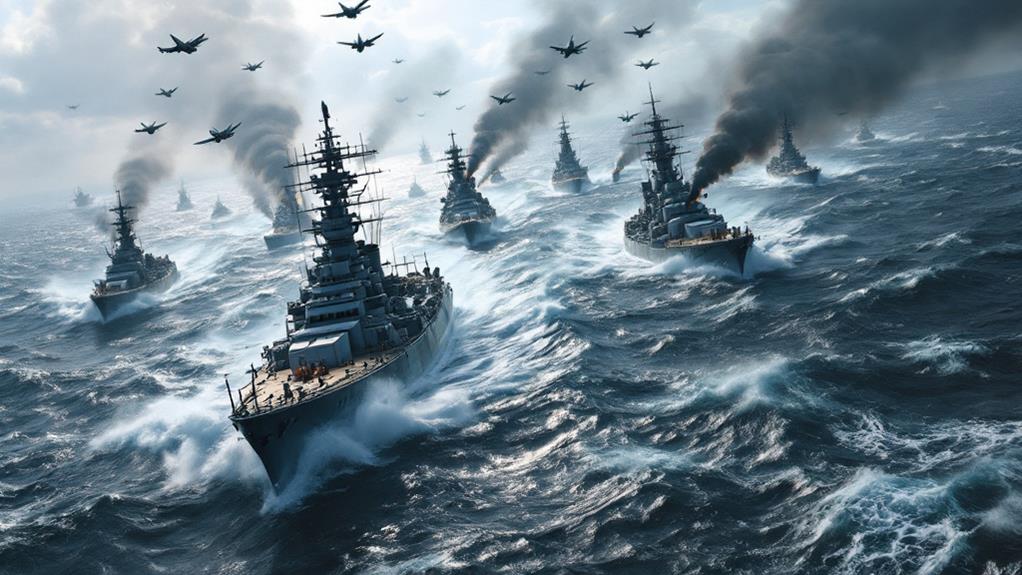
While the Battle of the Coral Sea unfolded, strategic naval movements played a significant role in shaping its outcome. Japanese forces aimed to seize control of Port Moresby, which would have enabled further Japanese expansion towards Australia. However, U.S. Task Force 17, under the command of Admiral Frank J. Fletcher, was essential in thwarting these plans. By positioning aircraft carriers like the USS Lexington and the USS Yorktown in the Coral Sea, the U.S. effectively countered the Japanese threat.
American codebreakers provided valuable intelligence, allowing U.S. forces to anticipate Japanese movements and prepare accordingly. This naval engagement was unique, as it was the initial in history where aircraft carriers led the combat, with fleets never directly engaging each other. Despite notable losses, such as the sinking of the USS Lexington, the Allies achieved a strategic victory, halting Japanese expansion and setting the stage for the critical Battle of Midway.
Here's why this mattered:
- Port Moresby would have been a gateway for further advances.
- Aircraft carriers changed naval warfare dynamics.
- Admiral Frank J. Fletcher's leadership was decisive.
- Battle of Midway was influenced by this outcome.
The Carrier Clash
The Battle of the Coral Sea stands out as a revolutionary moment in naval warfare history, where aircraft carriers became the forefront of combat. During this significant naval engagement in May 1942, the United States and Japan faced off in the Southwest Pacific with no direct ship-to-ship combat. Instead, the battle unfolded entirely through aircraft launched from carriers, a groundbreaking event in naval history. Both sides brought substantial air power into play, with the U.S. and Australia deploying 128 aircraft from two fleet carriers, while Japan fielded 139 aircraft from two fleet carriers and one light carrier.
Your understanding of this clash highlights its strategic importance. The United States and Australian forces aimed to prevent Japan's planned invasion of Port Moresby, a key target for Japanese expansion, which would have positioned Japan for a potential attack on Australia. Despite suffering losses, the Allies achieved a strategic victory by halting Japan's advance. The battle damaged the Japanese carriers Shōkaku and Zuikaku and sank the light carrier Shōhō, effectively weakening Japan's naval capabilities. This vital engagement not only thwarted Japanese expansion but also set the stage for the Allies' success at the Battle of Midway.
Battle Outcomes
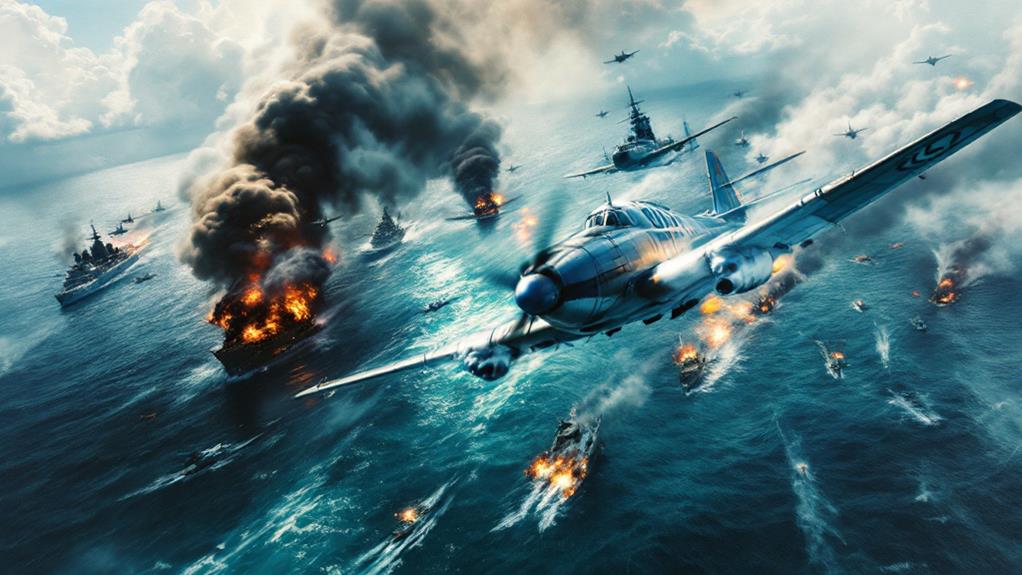
In the Battle of the Coral Sea, the Allies achieved a strategic victory that halted Japan's advance toward Australia, despite suffering tactical setbacks. This significant confrontation marked the initial time Japanese expansion was effectively stopped, preventing the invasion of Port Moresby. While the USS Lexington was lost, the battle's outcome proved vital in shaping the Pacific Theater's future.
American codebreakers played an important role by intercepting Japanese communications, enabling the Allies to anticipate and counter the Japanese naval forces' plans. The damage inflicted on the Japanese fleet carriers Shōkaku and Zuikaku prevented their participation in the significant Battle of Midway. This absence contributed to the eventual Allied victory at Midway, further curbing Japanese expansion.
The Battle of the Coral Sea also showcased the potential of carrier-based warfare. It demonstrated that aircraft carriers would play a central role in naval battles, influencing future strategies and engagements in the Pacific Theater.
Here's what you should remember about the battle outcomes:
- Strategic victory for the Allies, halting Japanese expansion.
- Prevention of Port Moresby's invasion.
- Japanese carriers incapacitated, impacting Midway.
- Carrier-based warfare's effectiveness highlighted.
Technological and Tactical Shifts
Naval warfare experienced a transformative shift during the Battle of the Coral Sea, where aircraft carriers took center stage. This naval battle marked the initial time opposing fleets engaged primarily through carrier-based air power, a critical change in naval warfare technology and tactics. The engagement highlighted the effectiveness of carrier-based air power, which became a dominant force in the Pacific Theater. As a result, these technological and tactical shifts played an essential role in preventing Japanese advances toward Australia.
American codebreakers were instrumental in this battle. By intercepting Japanese communications, they provided vital intelligence that allowed Allied forces to anticipate and counter Japanese plans for an invasion of Port Moresby. This strategic insight enabled U.S. forces to effectively utilize reconnaissance and improve coordination among their carrier groups.
The loss of Japanese carriers Shōkaku and Zuikaku markedly weakened Japan's naval capabilities. This setback contributed to their inability to execute further operations against Australia. The Battle of the Coral Sea underscored the importance of adapting strategies based on intelligence and reconnaissance, marking a turning point in how naval battles were fought. These shifts in tactics and technology set the stage for future engagements in the Pacific.
Long-term Implications
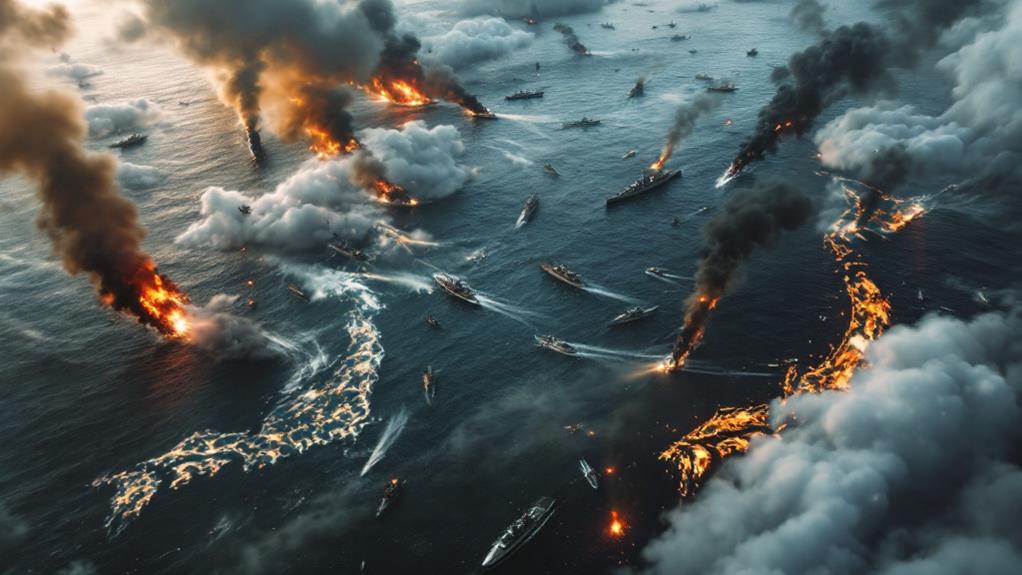
Building on the momentum from the Battle of the Coral Sea, Allied forces secured a strategic advantage that shaped future operations in the Pacific. This crucial battle not only halted Japan's advance toward Australia but also marked the initial significant check on Japanese expansion. By maintaining control over key supply lines and strategic airfields, the Allies guaranteed a steady flow of resources and reinforcements, essential for sustaining their efforts in the Pacific Theater.
The implications of this victory were far-reaching. The weakened Japanese naval power, unable to fully participate in the Battle of Midway, suffered further setbacks. This contributed to a shift in momentum, leading to successful Allied offensives that began to reclaim territories lost to Japan.
Moreover, the defense of Australia strengthened military alliances, particularly between Australian and American forces. These alliances laid the groundwork for coordinated operations that would prove crucial in the Pacific.
Key long-term implications include:
- Strengthened military alliances between Allies, fostering cooperation.
- Strategic airfields that facilitated future operations.
- Diminished Japanese naval power, reducing their threat.
- Shift in momentum in the Pacific Theater, leading to Allied offensives.
Ultimately, the Battle of the Coral Sea set the stage for Allied success in the Pacific.




